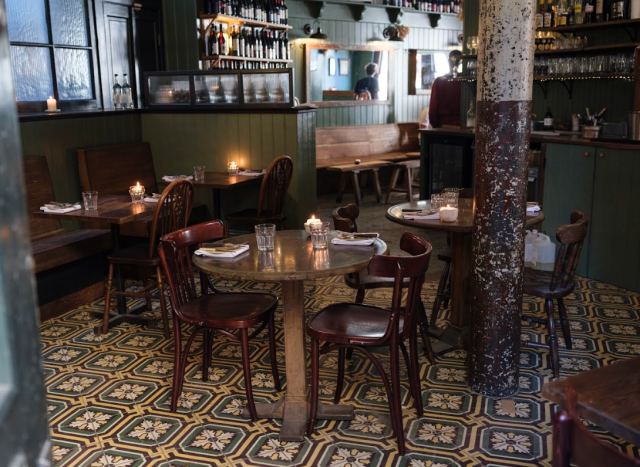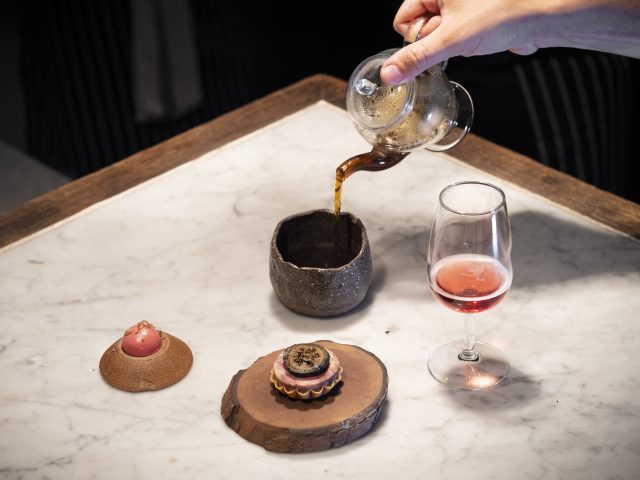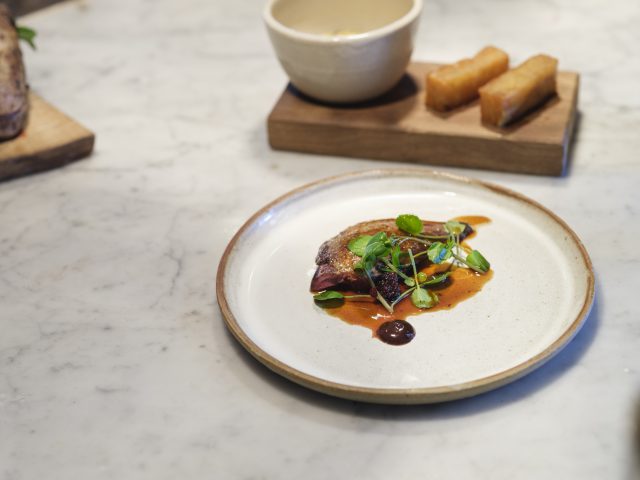This website uses cookies so that we can provide you with the best user experience possible. Cookie information is stored in your browser and performs functions such as recognising you when you return to our website and helping our team to understand which sections of the website you find most interesting and useful.
db Eats: Nest, Shoreditch
Louis Thomas gives the game season tasting menu at Nest’s new home in Shoreditch a shot. While there, he enjoys a gamut of grouse dishes alongside wines from Austria’s Burgenland.

Having migrated from Hackney to new premises in Shoreditch, Nest is very much in the throes of game season, the first season it offered when it opened six years ago.
The interior is fairly bare bones, and all the better for it. It’s stripped back, but comfortable enough
The first wine to be served was Ordinaire from Claus Preisinger, a Pinot Noir and Welschriesling pét-nat that, in spite of the funk that comes with the pétillant naturel (and isn’t necessarily to my palate), it provided some pleasing fresh red fruit and herbaceous aromas.
My colleague opined that it tasted as if “cider and Lambrusco had a child”, and suggested that it was “exactly what’s needed to revitalise me after being marched down the Northern Line.”
To pair, a liver parfait with beetroot and raspberry, a game terrine tartlet topped with a slither of (very) pickled walnut, and a grouse tea flavoured with reindeer moss. While the raspberry in the parfait naturally lent itself to the wine, the tartlet, with its intensity of “gamey” flavour (a vague term that will be deployed again in this review) and eye-wateringly tart garnish, was my favourite bite of the evening. The tea was also a delight, a sort of grouse Bovril, or “Grovril” if you will. As a drink in its own right, it didn’t require a pairing.

Next up, soda bread and “self-churned” butter topped with a zesting of dried grouse heart.
“The bread is the first recipe we developed,” our waiter explained. “It went into the oven eight years ago.”
“It doesn’t look over-baked to me,” I quipped, and he very courteously pretended that my remark was, indeed, funny.
Grated grouse heart might not be for everyone, but as an enthusiast of all things offal, I knew that its iron-rich hit would be a real treat, and I was proven right.
The next wine to arrive was Heinrich Naked White, a spontaneously fermented blend of Chardonnay, Welschriesling, Neuburger, Muscat, Grüner Veltliner and Weissburgunder. While it had that subtle spiced, slightly peppery lift that I particularly associate with Welschriesling and Grüner Veltliner, the “natural” character slightly detracted from the experience, but I would be the first to admit that I personally still like sulphites in my wine. My colleague concurred that the palate was preferable to the nose.
In a way, Nest’s move westwards mirrors how the tide of natural wine has flowed from the fringes of eastern London towards the centre. To continue the aquatic metaphor: natural is becoming mainstream.
However, even a wine that is not to my taste can be redeemed by a good dish served alongside, and the next course was certainly that. A deviation from the game theme, it was a perfectly, and I mean perfectly, cooked piece of chalkstream trout, hanged for a few days to dry the skin giving it a glass-like crunch. While I might question the logic of using English Chardonnay in the sauce while pairing it with a different wine (I do think that an austere English Chardonnay might have paired slightly better), this was a plate that demonstrated wonderful restraint, with the pickled daikon, hispi cabbage and roe each contributing a new textural element to it.
From the delicate to the punchy, the mixed game bird faggot with girolles and optional Wiltshire black truffle (which was, of course, opted for) was everything I want from a bundle of bits of meat, and would certainly give Mr. Brain a run for his money, though the addition of foam both obscured what was on the plate and felt largely superfluous flavour-wise.
What somewhat perplexes me is that I discovered that the same wine, Wachter-Wiesler Bela Joska, a single varietal Blaufränkisch, would be paired with the dish whether the customer forked out the extra tenner for truffle or not. A robust Blaufränkisch is certainly a good option for pairing with this prestigious fungus, but the addition of an atom bomb of an ingredient like black truffle completely changes the character of a dish, even a very gamey one, and if I were ordering a tasting menu with wine, I would want the pairing to take this into account.
I also suggested to my colleague that the pour was somewhat too generous, providing minimal margin for error when it came to the obligatory swirling, to which they (probably correctly) replied: “Let’s not knock them for that.”
The main event, a Yorkshire grouse snuggled into a cast iron Dutch oven, was presented to us in its whole form before we were then given a lopped off breast each. We were informed that the bird had received various pre-cook pamperings, including being smoked over juniper. I must confess, that particular nuance was lost on my palate, but what it did taste like was an exceptionally well cooked piece of meat from God’s own country. The same Blaufränkisch from the previous course was carried over for this one, and it was my favourite pairing of the night, its juicy black fruit quality echoing the elderberry jus, the slight bitterness nicely playing off the radicchio.

The accompanying potato side, consisting of layers of finely sliced spud that had been stacked together and deep fried was a bit TikTok 2021, but crispy fried potato is seldom a bad thing. More intriguing was what I can only describe as a squash porridge – the sort of side that would not be out of place on a Thanksgiving dinner table. While I wasn’t sure how it fitted in with the rest of that course, it was rather compelling in its strangeness, and I rather liked it.
After a cheese interlude, elevated by the addition of pickled plum and candied squash, the final wine graced us with its presence.
“Sometimes wine pairing takes a great deal of skill, but sometimes the wine is just so good,” we were told. Crossing the border from Austria into Hungary, we were presented with a 2019 Tokaji Szamorodni from Homonna, a wine which very much falls into the “so good” category.
Given that Burgenland, and particularly Neusiedlersee, can produce some sensationally good sweet wines, be they eiswein or appassimento-esque schilfwein, I was slightly rueful that there wasn’t an Austrian wine to complement the dessert, but 50 grams per litre of residual sugar and a touch of botrytic flair soon quelled any disappointment.
The bakewell tart dessert was delicious, and our waiter was right – the 100% Furmint Tokaji Szamorodni worked surprisingly well with the frangipane and raspberry.
The meadowsweet ice cream served alongside it was more divisive, with a medicinal quality that I rather enjoy but my colleague very astutely noted: “It smells like TCP antiseptic.”
Frantic Googling at the table uncovered that this is indeed a common tasting note for meadowsweet. Though I personally liked both the ice cream and the tart individually, the former did overwhelm the latter.
What I cannot knock whatsoever is the value of the tasting menu itself, coming in at £65 – a price that rarely gets you that many courses of such carefully and skilfully prepared food. £55 for the wine is about in line with what I’d expect for drops of that relative rarity. Not every pairing did hit the spot, and I would have preferred to have a wine with each course for the sake of variety (a critique I have levelled against other tasting menus), but it is nonetheless fantastic to see Burgenland wines in the spotlight – when was the last time you had good Blaufränkisch in London, let alone as a tasting menu pairing?
Nest is very much a haven for accomplished cookery and interesting wines, and where I did find fault in the menu, it was as a result of ambition rather than laziness. I will certainly make the pilgrimage on the Northern Line again.
Related news
Wine List Confidential: Dovetale

